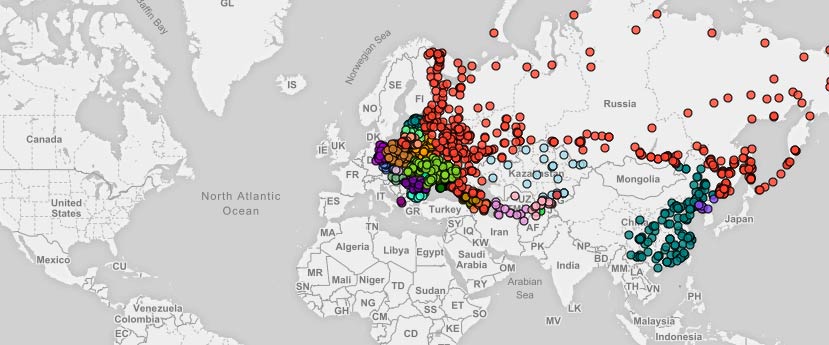1100 Declassified US Nuclear Targets
How many nukes do you think are needed for deterrence?
The National Security Archives recently published a declassified list of U.S. nuclear targets from 1956, which spanned 1,100 locations across Eastern Europe, Russia, China, and North Korea. The map below shows all 1,100 nuclear targets from that list, and we’ve partnered with NukeMap to demonstrate how catastrophic a nuclear exchange between the United States and Russia could be. If you click detonate from any of the dots, you can see how large an area would be destroyed by the bomb of your choice, as well as how many people could be killed.
Even though today’s nuclear targets list is classified, it probably doesn’t look dramatically different. The United States still has about 1,900 nuclear warheads deployed on missiles and bombers (with thousands more on reserve), ready to be launched at a moment’s notice and able to hit their targets within 30 minutes. This unstable situation is extremely risky and has repeatedly come close to triggering nuclear war by accident. Moreover, many of today’s hydrogen bombs are hundreds of times more powerful than the two atom bombs dropped on Hiroshima and Nagasaki. If a nuclear war were to break out today, nuclear winter might kill most people on Earth.
This leads to an important question: Just how many nuclear weapons do we actually need? Seven of the nine nuclear nations have determined that deterrence requires fewer than 300 nuclear weapons, and none of them have been attacked. Yet, not only do the United States and Russia each have approximately 7,000 nuclear warheads — accounting for 90% of the world’s arsenal – both countries are currently escalating the situation, making massive investments to enhance their arsenals with more accurate and lethal nuclear weapons. Many military analysts agree that the U.S. and Russia could easily meet their deterrence needs with much fewer nuclear weapons. Even the Pentagon has stated that the U.S. needs no more than 1,000 nukes to deter a nuclear attack. But don’t take their word for it: play with the map yourself and see just how destructive nuclear weapons can be!
1100 Nuclear Targets, Radioactive Fallout, and Weather
While the maps above show a general radius of nuclear destruction, weather patterns would play a role in how many people would be affected by nuclear fallout. Given that weather can change day to day, if we drop a nuclear bomb near a border in one country on the wrong day, innocent people in a neighboring country could also suffer the effects of radioactive fallout. How far and in which direction the radioactive materials travel would depend on the size of the bomb and the local weather. In the following graphics, Alex Wellerstein simulates two terrifying possibilities (We recommend viewing the following slideshows in the full-screen option to more easily see where the radioactive material will travel.):
1) What would have happened if all 1,100 nuclear targets were struck by a nuclear weapon of a given size on April 29, 2016?
In this slideshow, the bombs grow larger, and the nuclear fallout spreads farther from the target in a direction that’s dictated by the local weather patterns. Note that this slideshow doesn’t yet show the effect of nuclear winter: if enough smoke from nuclear fires rises high into the stratosphere, it can spread across our planet and trigger a decade-long mini-ice-age and farming collapse, potentially killing most of Earth’s 7 billion people.
2) How would the direction of radioactive fallout change if the bombs were dropped on three different days?
In this case, we use weather data from April 29, April 30 and May 1 of 2016 to see how the direction of nuclear fallout changes if 100 kt bombs were dropped on the 1,100 nuclear targets (typical bombs today are many times more powerful). Different weather patterns would send nuclear fallout in different directions on each day. Pay close attention to countries like Germany, Denmark and Finland, which could get hit with radioactive fallout if the nuclear targets were struck on the wrong day.
